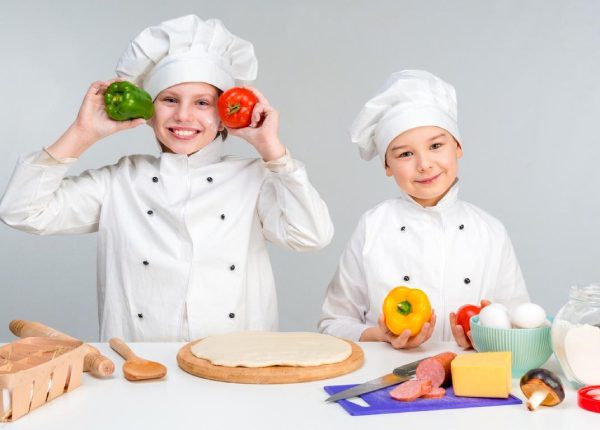To many, food trivia isn’t just about interesting and fun questions. It’s a tasty way to stimulate the curiosity and imagination of young minds concerning food!
In this article, therefore, we are going to explore the fabulous world of food trivia. As we discover fascinating facts and enjoyable stories told about different meals.
From the mysteries of healthy foods to secrets behind your favorite snack. Get ready for a mouth-watering adventure that will change the way you look at the meals.
What is food trivia?
Food trivia is all about interesting, unusual, or obscure facts regarding the world of food and the culinary world.
It often features unexpected histories, scientific events, cultural traditions, and peculiar questions about what we consume on a daily basis.
For kids, food trivia converts regular meals into fascinating revelations and wonders around foods that they constantly encounter and eat.
These questions often have a natural appeal on children as they bring two powerful kid’s interests together. Their curiosity towards the world and their everyday encounter with food.
Kids, also, get scientific ideas, historical details, geographical awareness, and a sense of their culture. While feeling like they are only learning interesting facts.



This underlying stealth learning approach enables information to stick without it feeling like homework.
Food trivia spans a huge variety of subjects to make sure there is always something of interest for all children. Some of the topics they cover include the following:
- Fruits and Vegetables. Interesting facts about where they come from, what colors they are, and how they can grow.
- Global Cuisine. Stories of famous dishes from different countries, such as sushi from Japan, pasta from Italy.
- Cooking Methods. An understanding of how various techniques such as grilling or sautéing, or baking etc., influence taste and nutrition.
- Food Science. The science behind why bread rises, or the reason why popcorn pops.
- Snack Origins. Amazing stories of the creation of popular snacks that sometimes came about by accident.
- Cultural Traditions. The importance of food in festivals, celebrations, and everyday lives in various cultures.
Food trivia is a playful combination of knowledge and entertainment to prompt kids to consider food more than a mere item to eat.
Why is food trivia beneficial for kids?
Food trivia is a deliciously disguised educational tool that can contribute to children’s development in many ways, much more than simply entertaining them.
By using interesting facts related to everyday foods, kids obtain significant cognitive, nutritional, and social benefits, including.
Educational tool.
Food trivia helps develop children’s vocabulary and general knowledge, in an interesting manner. Facts about food origins, expand their sense of history, geography, and science.
Cultivating curiosity.
Food trivia arouses children’s curiosity by disclosing surprising facts that prompt kids to ask questions. And learn more about the world of food that exists beyond their plates.
Healthy relationships with Food.
Food trivia can help encourage healthy eating habits by emphasizing the nutritional values of fruits and vegetables. As well as promote lifelong healthy choices.
Social and emotional development.
Food trivia enables people to socialize meaningfully, especially when integrated into family meals or group activities
Cognitive development.
The question and answer nature of food trivia enhances critical thinking and information processing. They help boost neural tracks which are crucial for learning and memory storage.
Practical life skills.
Information about food storage, preservation, and cooking skills establishes a basis for future understanding regarding food safety and preparation.
Food trivia helps sow the seeds for lifelong learning among kids as they develop healthy relationships with what they eat.
Keep your kids safe while exploring food trivia online
Popular food trivia questions for kids
There are several trivia questions about food that will make a perfect recipe for learning and fun. Serving bite-size knowledge to satisfy the appetite of children’s curiosity.
These questions have the potential to turn regular moments into opportunities for interaction and discovery.



Here is a set of appropriate food trivia questions divided based on levels of difficulty and topic covered.
Easy food trivia questions
These questions are ideal for younger children who are still new to the exploration of the world of food outside their plates.
Examples of simple trivia questions under various categories are as follows:
Fast Food Trivia:
- Which famous breakfast dish has a shape of the letter O? (Answer. Cheerios/donut)
- What is the traditional dessert that people eat at birthdays? (Answer. Cake)
- What frozen dessert is sold on a stick or in a cone? (Answer. Ice cream/popsicle)
- What kind of sandwich is made with peanut butter and fruit spread? (Answer. PB&J sandwich)
- Which food comes in a cardboard box and commonly consumed during parties? (Answer. Pizza)
Healthy Food Trivia:
- What is a red fruit that is commonly confused for a vegetable and used in salads? (Answer. Tomato)
- What is the green vegetable that resembles a little tree? (Answer. Broccoli)
- Which is that fruit that is yellow, curved and that has to be peeled before you can eat it? (Answer. Banana)
- Which fruit has seeds on the outside instead of the insides? (Answer. Strawberry)
- Which vegetable makes your eyes water when you cut them? (Answer. Onion)
Cultural Dishes
- What Italian food is circular, with sauce and cheese on top, served in slices? (Answer. Pizza)
- What is a Mexican food that’s a rolled tortilla stuffed with meat or beans? (Answer. Taco)
- What is the Japanese food that is made out of rice and commonly wrapped in seaweed? (Answer. Sushi)
- What type of bread is usually eaten with curry in India? (Answer. Naan)
- What is the national dish in England? (Answer. Chicken Tikka Masala)
Medium and challenging food trivia questions
These questions are questions aimed at older children who are developing more knowledge of food and cooking.
Some good examples of these types of trivia questions would be as follows.
Fast Food Trivia
- Which fast-food restaurant claims to have invented the first drive-thru window? (Answer. In-N-Out Burger)
- What is the original name of the Big Mac? (Answer. The Aristocrat)
- Which popular sandwich filling was invented by a doctor in 1890’s as a “health food”? (Answer. Peanut butter)
- What is the name of that popular fast-food side dish that was first offered in Belgium and named after the French word for “fried”? (Answer. French fries)
- What breakfast food came to be as a result of a mistake by a chef dropping pancake batter onto a hot iron? (Answer. Waffle)
Healthy Foods
- What was previously a purple/ orange vegetable that was selectively adapted to become yellow? (Answer. Carrot)
- Which grain, which is present in oatmeal, is famous for maintaining your heart health? (Answer. Oats)
- Which nutrient that is present in spinach helped ancient sailors to be strong during the long voyages? (Answer. Iron)
- What nut is called “brain food” due to its shape imitating the shape of the human brain? (Answer. Walnut)
- Which is the vegetable that was first cultivated over 7,000 years ago in South America and it has over 4,000 varieties? (Answer. Potato)
Cultural Dishes
- What would you call the Chinese dish, typically stuffed with meat or vegetables and steamed or fried to become half-moons in shape? (Answer. Dumpling)
- What is the name of the Ethiopian flatbread that can be used to pick up stews and that is made of teff cereal grain? (Answer. Injera)
- What is the spicy Korean dish comprising of fermented cabbage and seasonings? (Answer. Kimchi)
- What is the chief ingredient of the traditional Japanese miso soup? (Answer. Fermented soybeans)
- Which bean is used to make the traditional hummus in the middle Eastern cuisine? (Answer. Chickpeas)
How to make food trivia more engaging
Just spewing facts can be rather boring. To effectively capture kid’s attention, the food trivia ought to be made interactive.



Here is how we can mix things up and keep kids interested in food trivia.
1. Turn trivia into fun games
You could turn the food trivia into cute and fun formats that kids will enjoy. These may include.
- Quiz shows. Make use of buzzers or a whiteboard to replicate a game show.
- Scavenger hunts. Scatter trivia questions in the house or classroom with small food rewards.
- Trivia bingo. Come up with bingo cards on trivia answers and read out clues as questions.
These interactive techniques make kids remain active and make their memory and desire to learn, stronger.
2. Let kids be the quiz masters
One very effective way to increase involvement can include allowing the kids to generate questions for their quiz on food trivia.
Let them host as the quiz master for the family or friends! This will inturn:
- Encourages creativity
- Strengthens their research and writing skills
- Motivates kids to learn more.
They can make question cards, produce slide shows, or even record themselves asking trivia questions and sharing with others.
3. Use visuals to bring facts to life
Images, short videos, and infographics can take food trivia to exciting and engaging new levels —particularly for younger kids.
Explaining how a popcorn pops of what a dragon fruit looks like is visually thrilling and helps kids to remember what they learn.
Web sites, such as YouTube Kids could provide safe and age-appropriate video content that goes along well with the trivia themes.
4. Use digital tools with safety in mind
There are tons of apps and websites with trivia games and quizzes about food, but it is crucially important to make sure children are safe when using these apps.
Parental control tools have proven to be very useful in protecting children when using digital platforms. Helping to keep them safe in the online environment.



FlashGet Kids is one such parental control tool that is praised for helping parents monitor and control their children’s device usage.
FlashGet Kids offers quite a number of useful features for protecting kids including the following.
- Real-time alerts. You receive alerts on questionable or dangerous activity on your child’s device, so that you can take necessary action.
- Daily usage reports. Provides daily reports on how and the amount of time that kids spend on trivia apps or games, making sure you know of their activities.
- Screen mirroring. Enables you to view your child’s screen from your phone in real time which is useful when helping them during trivia games.
- Album safety. Identifies and flags trivia visuals or downloads that are not safe in your child’s phone.
With the help of such a tool as FlashGet Kids, parents can advance their children’s digital learning. Whilst still making sure that they are safe online.
Tips for parents and educators
Choosing the right food trivia is imperative if you want to keep kids interested in food facts without annoying them. The following tips will be useful for parents and educators.
1. Consider the age group.
What might be appealing for a child aged ten may turn out to be merely confusing or simply boring to a five-year-old.
2. Start with the familiar.
Start with food trivia on those foods the children know and love. To establish a sense of connection and make the learning more relevant.
3. Balance difficulty levels.
Combine easy questions with some that are slightly more difficult to keep all children interested. And so that every child answers at least some questions correctly, to boost confidence.
4. Make it a positive experience.
Let the mood be light-hearted and fun. The idea is to generate curiosity and interest in learning about food, not to build pressure.
5. Connect to real-life experiences.
Where possible, relate food trivia to pertinent situations in real life. This is so that the children appreciate the relevance of what they are learning.
With these guidelines in mind, parents and educators will be able to curate a library of food trivia. That is interesting for kids at all age levels.
Conclusion
Food trivia turns the very act of eating into an adventure of discovery for the inquisitive young stars.
A closer look at the surprising stories behind what is in their plates can help children learn more than mere facts. They learn to appreciate the amazing journey of food from farms to plates.
From laughing about how pineapples grow to being fascinated by the way honeybees use dance as a language. These sweet morsels of knowledge provide a lifelong desire to learn.

